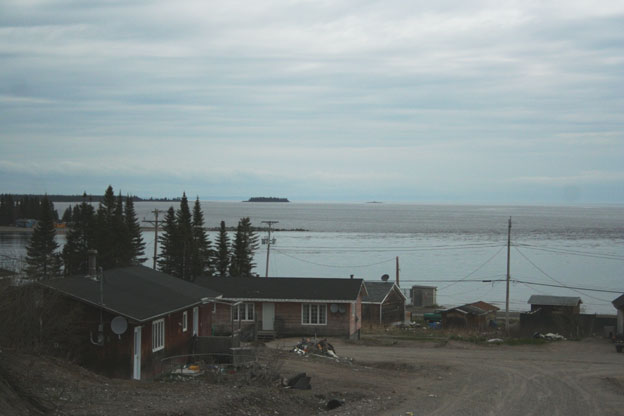What would you do with $908? Take a cruise to Alaska? Buy a nice new bicycle? A TV? 900 boxes of Kraft Dinner? Bury it under a large rock?
Maybe you’d go grocery shopping?
There is no real grocery store in Gull Bay First Nation, an Anishinaabe community about 200 kms north of Thunder Bay. There is no good public transit connection between Gull Bay and Thunder Bay, meaning you drive. If you can’t afford a car or gas, you have to take a taxi. And you had better fill that cab to the gills, because it’s $908 round trip.
That’s $908 plus the cost of groceries.
A resident of Gull Bay shared this anecdote with Mike Balkwill, provincial organizer for the Put Food in the Budget campaign, on his 2014 tour of communities in northwestern Ontario. Mike has spent most of his life working with people living on a low-income in southern Ontario (specifically the GTA), and was invited to travel north this summer by Kathy Campbell, Executive Director of an emergency women’s shelter in Red Lake.
Kathy suggested a learning tour, of sorts, because poverty in the north is not like poverty in southern Ontario.

Elsewhere I’ve discussed how where we’re situated affects our experiences of poverty and food, among other things. It is therefore quite helpful to go along with Mike, to hear through him about our northern neighbours’s experiences. In his words, here are some “highlights” from his tour:
Boomtown and bust: There are two classes of people in Red Lake. Those who toil in the local gold mines who can earn $150K a year (they’re mostly from out of town). And the rest: people in low-wage jobs or receiving social assistance.
Fruit for thought: Fruit bought from the local store must be eaten the same day because it’s usually overripe by the time it even reaches the community.
Poor people face terrible choices: Hydro can cost $1,000 a month, and even more in winter for poorly insulated homes with electric heat. Ontario Works will pay these electricity bills for social assistance recipients but only by reimbursement. People whose family or friends can’t front the cash risk having their hydro shut off and even eviction. Others have to take out loans.
If you don’t have a car… The community health centre on the main highway in Ignace receives coupons for free milk from the local grocery store from time to time. But the trailer park where many of the poor live is three kilometres from the health centre. If you don’t have a car, you can walk — at least during the 12 weeks of the year that Ignace enjoys good enough weather — or take a cab. Round trip fare to pick up free milk coupons: $17.50.
Food banks starved: Some food banks are so starved of donations that at least in Ignace one local judge directs U.S. fishermen who break the rules to pay their fines to the food bank.
“Mom, why are we so poor?””This is the question the young son of Sasha, a woman I met in Atikokan, asked when she couldn’t buy a $3 toy he wanted. Sasha’s son is asking a profound question. Ontario is a prosperous province. Why are so many people poor?
Abject poverty and conspicuous summer wealth: In rural Ontario, homelessness is next to invisible. Unstable housing — couch surfing, camping and sleeping in trailers or sheds in the woods — is not unusual. During summer months, when tourists flock in to enjoy the nature, many merchants raise prices leaving locals without enough money to cover the basics.
Social mobility on the outs: In some communities more than one in five men leaves home to work in Alberta or Saskatchewan.
Much of what Mike heard in north Ontario reminds me of the years my family spent living in Labrador, so I called my mom and asked her about our eating habits there. We lived in an Innu community, where the preferred foods were wild: caribou, porcupine, fish and partridge. Unless there were NATO jets practicing low-level flying maneuvers these foods were relatively abundant at the time. Our fruits were also wild. I remember the hours (that actually felt like days) we spent picking wild blueberries and swatting black flies. I also remember worrying that I’d never outrun the bears with so many berries in my stomach.
Similar to northern Ontario, we were physically isolated from much of the rest of Canada; food was expensive and generally not fresh.

The community we lived in, and the larger “city” down the road were not connected by land to the rest of Canada. Anything not from our little pocket of Labrador came in by plane or boat. Fresh fruits and vegetables were “virtually nonexistent,” says my mom. She remembers buying corn on the cob, in a can, and how thrilling it was when my grandparents visited with a flat of fresh strawberries. Soon after moving there my mom stopped buying bread, which was often moldy. Instead, she started making her own. Seven loaves a week, and if there was caribou, maybe some pakueshikan: baking powder, water and flour, fried on the stove. Milk was almost prohibitively expensive, so she found and ordered “high quality” powdered milk, which she ‘cut’ with a bit of liquid homogenized milk.
Like northern Ontario, it was a difficult and borderline absurd exercise to try to abide by the Province’s “Nutritious Food Basket” Guideline Document; most of the contents of that basket were simply unavailable. We could sort of afford to eat well, and my parents worked hard to make sure we did — even though all I ever wanted to eat was vienna sausages:

So keep an eye on Mark’s dispatches, and keep on pushing our province to PUT FOOD IN THE BUDGET!



